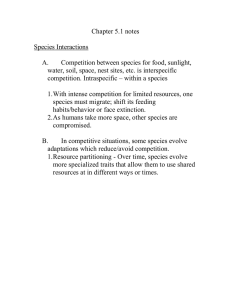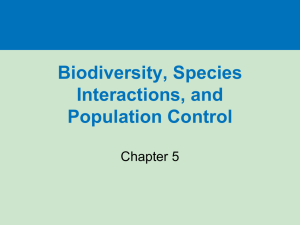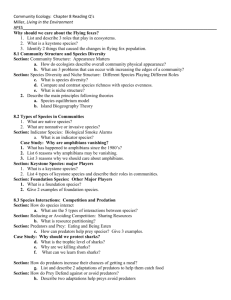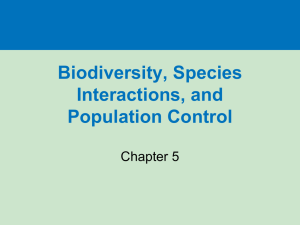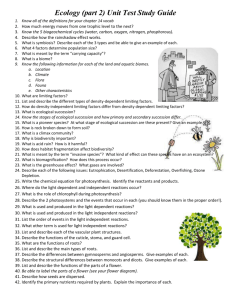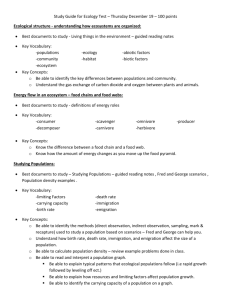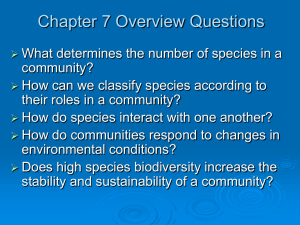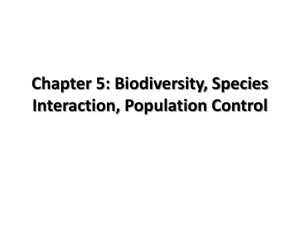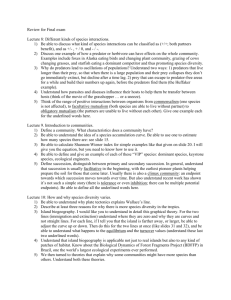Chapter 6-Population and Community Ecology
advertisement
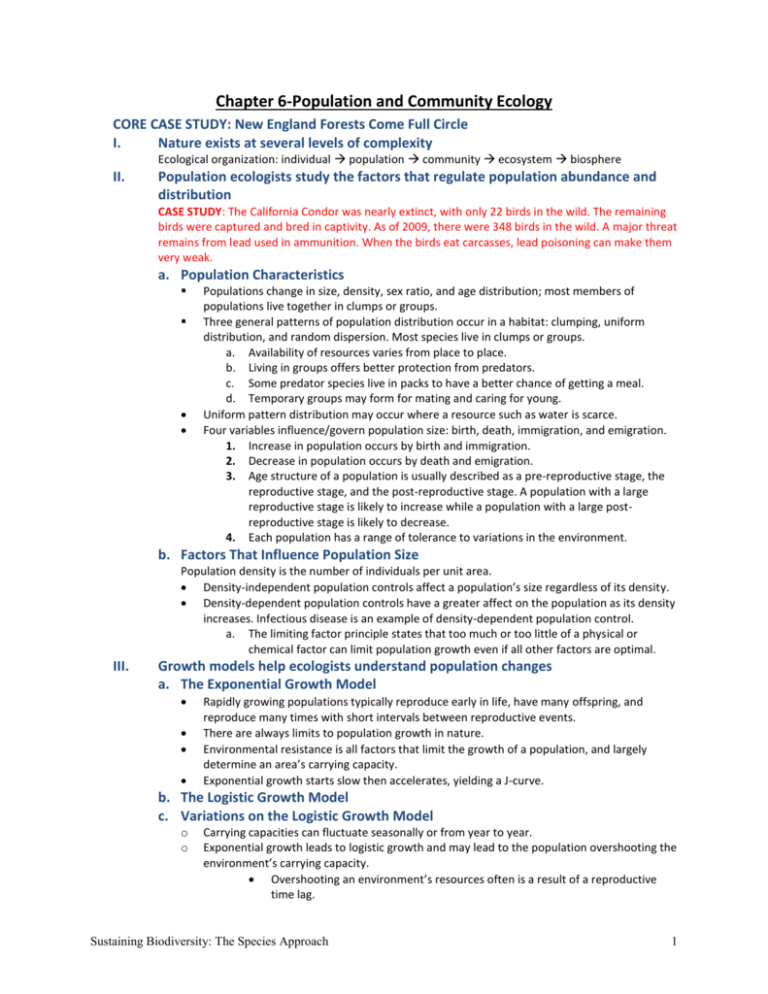
Chapter 6-Population and Community Ecology CORE CASE STUDY: New England Forests Come Full Circle I. Nature exists at several levels of complexity Ecological organization: individual population community ecosystem biosphere II. Population ecologists study the factors that regulate population abundance and distribution CASE STUDY: The California Condor was nearly extinct, with only 22 birds in the wild. The remaining birds were captured and bred in captivity. As of 2009, there were 348 birds in the wild. A major threat remains from lead used in ammunition. When the birds eat carcasses, lead poisoning can make them very weak. a. Population Characteristics Populations change in size, density, sex ratio, and age distribution; most members of populations live together in clumps or groups. Three general patterns of population distribution occur in a habitat: clumping, uniform distribution, and random dispersion. Most species live in clumps or groups. a. Availability of resources varies from place to place. b. Living in groups offers better protection from predators. c. Some predator species live in packs to have a better chance of getting a meal. d. Temporary groups may form for mating and caring for young. Uniform pattern distribution may occur where a resource such as water is scarce. Four variables influence/govern population size: birth, death, immigration, and emigration. 1. Increase in population occurs by birth and immigration. 2. Decrease in population occurs by death and emigration. 3. Age structure of a population is usually described as a pre-reproductive stage, the reproductive stage, and the post-reproductive stage. A population with a large reproductive stage is likely to increase while a population with a large postreproductive stage is likely to decrease. 4. Each population has a range of tolerance to variations in the environment. b. Factors That Influence Population Size Population density is the number of individuals per unit area. Density-independent population controls affect a population’s size regardless of its density. Density-dependent population controls have a greater affect on the population as its density increases. Infectious disease is an example of density-dependent population control. a. The limiting factor principle states that too much or too little of a physical or chemical factor can limit population growth even if all other factors are optimal. III. Growth models help ecologists understand population changes a. The Exponential Growth Model Rapidly growing populations typically reproduce early in life, have many offspring, and reproduce many times with short intervals between reproductive events. There are always limits to population growth in nature. Environmental resistance is all factors that limit the growth of a population, and largely determine an area’s carrying capacity. Exponential growth starts slow then accelerates, yielding a J-curve. b. The Logistic Growth Model c. Variations on the Logistic Growth Model o o Carrying capacities can fluctuate seasonally or from year to year. Exponential growth leads to logistic growth and may lead to the population overshooting the environment’s carrying capacity. Overshooting an environment’s resources often is a result of a reproductive time lag. Sustaining Biodiversity: The Species Approach 1 The reproductive time lag can produce a dieback/crash of organisms unless the organisms can find new resources or move to an area with more resources. Four general types of population fluctuations in nature are: stable, irruptive, cyclic, and irregular. A stable population fluctuates slightly above and below carrying capacity and is characteristic of many species living under fairly constant environmental conditions. Some species have a fairly stable population size that may occasionally irrupt to a high peak and then crash to below carrying capacity. This is characteristic of short-lived, rapidly reproducing species. Cyclic fluctuations occur over a regular time period, generally a multiple-year cycle. Humans are not exempt from population crashes. Examples include the Irish potato famine, the bubonic plague, and the current AIDS epidemic. d. Reproductive Strategies and Survivorship Curves Species use different reproductive patterns. i. Some have many offspring and give them little protection. ii. Some have few offspring that are cared for by their parents. IV. e. Metapopulations Community ecologists study species interactions Five basic species interactions are competition, predation, parasitism, mutualism, and commensalism. a. Competition Competition between species for food, sunlight, water, soil, space, nest sites, etc. is interspecific competition. 1. With intense competition for limited resources, one species must migrate, shift its feeding habits/behavior, or face extinction. 2. As humans take more and more space, other species are compromised. In competitive situations, some species evolve adaptations that reduce/avoid competition for resources. 1. Over a long time, species evolve more specialized traits that allow them to use shared resources at different times, in different ways, or in different places; this is termed resource partitioning. b. Predation Predator-prey relationships define one species (the predator) feeding/preying on another. 1. Predators have a variety of ways to capture prey. Herbivores feed on immobile plant species; carnivores use pursuit of prey or ambush to capture prey. Some predators use camouflage, and others use chemical warfare (venom) to capture prey or deter predators. 2. Prey species escape predators in a number of different ways such as swift movement, protective shells, camouflage, or use of chemicals to repel or poison. 3. Coevolution is when predator and prey can exert intense natural selection pressures on one another. 4. Parasites live on or in another species. The host of this arrangement is obviously harmed by it, but the parasite can contribute to biodiversity by controlling the size of specific species populations. c. Mutualism Sustaining Biodiversity: The Species Approach 2 Mutualism is a relationship that benefits both species; these benefits can be in dispersing pollen and seeds for reproduction, in receiving food, or in receiving protection. 1. Mutualism is not cooperation; each species exploits the other. d. Commensalism Some species interactions help one species but does nothing for the other; this is commensalism. Examples of this are the bromeliads and orchids (epiphytes). e. Keystone Species Keystone species have a large affect on maintaining balance within an ecosystem. a. Can be, but are not necessarily, pollinators and top predators. b. Foundation species create and enhance habitats that benefit other species. V. The composition of a community changes over time With new environmental conditions, community structures can change; one group of species is replaced by another. a. Ecological succession is the gradual change in species composition of a given area. The classic view of ecological succession is that it is an orderly sequence, each stage leading to the next, more stable stage until a climax community is reached. Such a community would represent the balance of nature, one dominated by a few long-lived plant species that is in balance with its environment. Changes in environmental conditions that disrupt a community can set back succession. a. Scientists can’t predict the course of a given succession in a community toward a stable climax community in balance with its environment. a. Primary Succession Primary ecological succession is the gradual establishment of biotic communities on lifeless ground; in the soil there is no terrestrial community; in an aquatic community, there is no bottom sediment. This process generally takes a very long time. b. Secondary Succession Secondary ecological succession defines a series of communities with different species developing in places with soil or bottom sediment. The soil or sediment remains after the natural community of organisms has been disturbed, removed, or destroyed. a. Forest fires or deforestation, for example, can convert a particular stage of succession to an earlier stage. c. Aquatic Succession VI. The species richness of a community is influenced by many factors a. Latitude b. Time c. Habitat Size & Distance: The Theory of Island Biogeography d. Conservation and Island Biogeography WORKING TOWARD SUSTAINABILITY: Bringing Back the Black-Footed Ferret Sustaining Biodiversity: The Species Approach 3
